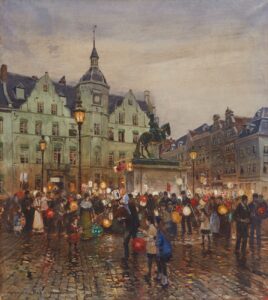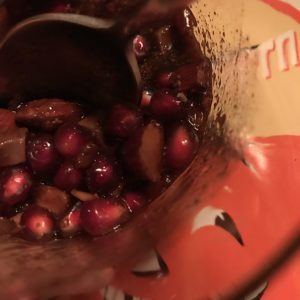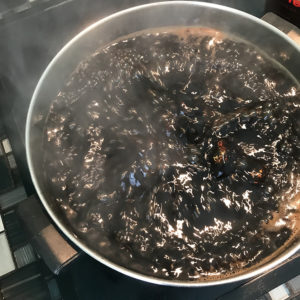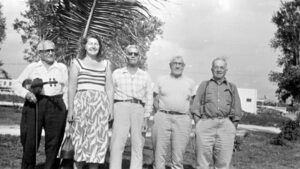I did warn you on Hallowe’en night that your Convivio Book of Days Calendar for November would be belated, and boy, was I right about that! But here it is (click here for the calendar), finally, in plenty of time for St. Martin’s Day, or Martinmas, which approaches this weekend on the 11th. Martinmas brings the conclusion of our annual autumnal days of remembrance, this time of year when we particularly keep close in heart and mind those who have come and gone before us.
Of course we honored these days of the dead at the start of the month with Hallowe’en and All Saints and All Souls. But the connection of Martinmas to the days of the dead is just as strong, through memory. Before the change to the Gregorian Calendar, the 11th of November was Samhain, the Celtic New Year. Another name for Martinmas is Hollantide, and just as Hallowe’en is a corruption of the words All Hallow’s Eve, so is Hollandtide, which comes from Hallowtide: the time of the sacred, the holy. Many of our contemporary Hallowe’en traditions come out of Hollantide traditions: the carving of turnips (replaced by pumpkins here in America) into Jack o’ Lanterns and the going door to door in search of soul cakes, which has evolved into the trick-or-treating we know today. The day is also a traditional weather marker: If ducks do slide at Hollantide, At Christmas they will swim. / If ducks do swim at Hollantide, At Christmas they will slide. / Winter is on his way / At St. Martin’s Day.
And with Martinmas, winter certainly is on its way: the nights are much longer than they were just a few weeks ago at the equinox, and still growing longer as we approach the solstice of midwinter that will arrive in six weeks’ time. The increasing darkness informs one of the great Martinmas traditions, especially in Germany, where after sunset on St. Martin’s Day, people gather outdoors with lanterns, often homemade, shining warm light onto the chilly night. And it is a scene just like this that is the cover star for this month’s calendar: it’s a 1905 watercolor by Heinrich Hermanns depicting those St. Martin’s Day lanterns in Düsseldorf, Germany.
Martinmas also has much to do with wine, for it is time for the first tasting of the wine that was put up to ferment in September. These are not aged wines, mind you, but young new wines: think Beaujolais, for instance. This has to do with timing (this year’s wine has had a few weeks to ferment by now) and with the good saint himself, St. Martin of Tours, being a patron saint of winemakers. It is also the last big religious feast before Advent, that time of preparation for Christmas. In earlier days, Advent was a season of fasting, and so Martinmas was a very big deal, a chance to indulge. Traditional Martinmas foods include goose and turkey, and also chestnuts and in Italy, very hard biscotti, some of which are baked not just twice like regular biscotti but three times. The extra baking makes them hard as rocks, but with good reason: Biscotti di San Martino are meant to be dunked in that new wine that we’re drinking on his day.
And with this day’s passing, Advent fast approaches. At our online shop, you’ll find traditional Advent calendars from Germany and Advent candles from both England and Sweden. We don’t sell anything anyone really needs, but I would say we do sell many useful things, and these simple candles and calendars are indeed useful: they help us slow down, they help us set a pace for the Christmas joy that is to come, and perhaps help us appreciate it, too, and this is the value of Advent and this time of preparation that is to come. Martinmas, Thanksgiving, Advent. Enjoy each as it comes. This is what we mean by enjoying the ceremony of each day.
COME SEE US!
We’d love to see you at our pop-up shops at these upcoming events in South Florida. These are the ones we currently have planned:
DELRAY BEACH 100′ CHRISTMAS TREE LIGHTING & YULETIDE STREET FAIR
We’ll be there near the 100′ tree in our 10′ tent with a nice little shop of Advent candles and calendars and Christmas goods from Germany, Sweden, and Mexico. Tuesday November 28 from 6 to 9 PM at Old School Square, Downtown Delray Beach.
CHRISTMAS MARKET MIAMI
We’ll have a huge pop-up shop of handmade artisan goods from Germany plus specialty foods, too, and our Advent candles and calendars. Saturday December 2 from 11 AM to 8 PM, indoors and outdoors (we’ll be indoors) at the German American Social Club in Miami, which is where we spent Oktoberfest this year. 11919 SW 56th Street, Miami.
SANKTA LUCIA FESTIVAL & JULMARKNAD
This lovely festival is a fundraiser hosted by SWEA, the Swedish Women’s Educational Association. It will be held at the First United Methodist Church of Boca Raton at 625 NE Mizner Boulevard on Saturday December 2 from 11 AM to 3 PM. Our pop-up shop will feature traditional and contemporary Swedish Christmas items plus Advent candles and calendars, and some delicious German Christmas cookies and candies, too. (Same day as the Christmas Market in Miami, but don’t worry, we’ll be at both!)
KRAMPUSNACHT
On the Eve of St. Nicholas’ Day, it is Krampus who accompanies the good saint to scare girls and boys into good behavior, and he gets his own celebration at the American German Club in suburban Lake Worth on Friday evening, December 8, from 7 to 11 PM. We’ll be there with our biggest pop-up shop ever as this night ushers in the weekend’s Christkindlmarkt. Tickets required and must be purchased in advance. 5111 Lantana Road, Lake Worth.
CHRISTKINDLMARKT
It’s our favorite event of the year! The annual Christkindlmarkt at the American German Club in suburban Lake Worth is just wonderful, and we’ll be there with our biggest pop-up shop ever, filled with German Christmas artisan goods plus more from Sweden and Mexico, as well as specialty foods and who knows what else! Tickets are required and must be purchased in advance. Usually sells out! Saturday December 9 from 2 to 10 PM and Sunday December 10 from 12 to 8 PM. 5111 Lantana Road, Lake Worth.
Image: “Sankt Martins Zug vor dem Düsseldorfer Rathaus” by Heinrich Hermanns. Watercolor on paper, 1905 [Public domain] via Wikimedia Commons.





